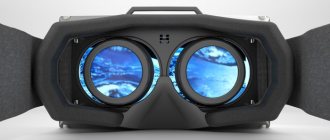What is virtual reality?
Before talking about virtuality glasses, let’s outline what these devices interact with. The term “virtual reality”, contrary to stereotypical ideas, does not only refer to computers. The word “virtuality” arose a long time ago, but had a different meaning.
Ancient people did not know how virtual reality worked. Derived from the Greek v i r
, which means “man,” the word “virtuality” among the Romans meant “the totality of all male qualities.” And only with the spread of new technologies, the concept of “virtuality” began to expand in meaning.
What virtual reality is and how it works is not difficult to understand.
VR is a transfer into a simulation created using computer technology.
This way we get the opportunity to perceive the surrounding virtual space with our senses. Virtual reality devices become mediators in this process. The most accessible of them today are virtual glasses, which are often used together with joysticks and controllers.
Who created virtual reality glasses
The world first learned what virtual glasses are in the middle of the last century, in 1956. Then the first prototype arose, working in the same way as reality glasses work. Sensorama 3D devices
, which had a special display with a three-dimensional image. In addition, they were equipped with stereo sound, vibrating seats and even an odor generator. Cinematographer and director Morton Heilig, who created this unusual device, shot 6 films for it using a special camera.
Virtual reality glasses, as they are known today, became known only in 1982. This happened thanks to the RB2
. But 2 years earlier, a significant breakthrough was made by Steve Mann. He invented a computer system that connects to the helmet and viewfinder. The principle of the invention was also similar to how virtual glasses work. But at that time, the cost of acquisition was so high that it was not available to a person with an average salary. And the question of whether there are virtual reality glasses was asked much more often.
What are VR glasses for?
A wide circle learned about what Viar glasses are thanks to the gaming industry. In the early 10s of this century, video games tailored specifically for VR devices became more accessible and increased in number. But not only gamers know why virtual reality glasses are needed; these devices are also used for training and work. For example, for assembling parts, when all drawings and diagrams are transferred to the master’s display. Or in driving schools, where the effect of presence helps students better understand the situation on the road. Many students studying to become surgeons and airplane pilots have already tried out how virtual reality glasses work.
How do virtual reality glasses work?
The most common means of immersion in virtual reality are specialized helmets/glasses that are placed on a person’s head.
The operating principle of this helmet is quite simple. 3D video is displayed on the display in front of your eyes. A gyroscope and accelerometer attached to the body track head turns and transmit data to a computer system that changes the image on the display depending on sensor readings.
As a result, the user has the opportunity to “look around” inside the virtual reality and feel in it as in the real world. To ensure that the image has high clarity and always comes into focus, special plastic lenses are used.
For a more realistic immersion in the world of virtual reality, in addition to sensors that track the position of the head, VR devices can use various tracking systems, such as:
- Eye tracking systems. Designed to track the movement of the pupils of the eyes and allow you to determine where a person is looking at each moment. At the moment, such systems are not widely used in the consumer services market and are used mainly for various medical and scientific research.
- Motion tracking. They track any human body movements and repeat them in the virtual world. Tracking can be carried out using special sensors or a video camera aimed at a person.
- 3D controllers. In order to feel as comfortable as possible while in virtual reality, traditional 2D controllers (mice, joysticks, etc.) are replaced by manipulators that allow you to work in three-dimensional space - 3D controllers.
- Devices with feedback. Such devices began to be developed back in the 90s and are designed so that the user can literally experience everything that is happening in the virtual world. Vibrating joysticks, swivel chairs, etc. can be used as such devices.
For a long time, the source of 3D images for a virtual reality device was a computer or a user console (for example, PlayStation VR). However, a couple of years ago, “budget” VR devices entered the market, in which a smartphone began to be used as a source of 3D images. A more simplified design made it possible to significantly reduce the cost of virtual reality devices, since there was no need to equip glasses with the previously listed technical means, because:
- Modern smartphones are highly productive and are capable of independently processing even the most “heavy” 3D content.
- Smartphone displays have a fairly high resolution.
- Almost every smartphone has sensors for determining the position of the device in space.
Where did the VR helmet come from?
A virtual helmet is a high-tech device that appeared along with glasses. Their difference lies in a larger set of functions, because The helmet includes both a display and headphones. This creates both an audio and visual effect of being in the simulation. The virtual gaming headset is one of the most famous versions of this device. If the gadget is equipped with a microphone, it is able to perceive and transmit even more information.
The first attempt to create such a helmet was made by an American company in the 90s, but it was not successful.
A little later Sony
tried to do the same, but the developments were again not widespread. Only a few knew how a virtual reality helmet works. Such equipment could only be used as an addition to training equipment for military personnel or pilots. But over time, the prototypes were refined and became more accessible.
Sword of Damocles
Another progenitor of a virtual reality helmet. Developed at the Massachusetts Institute of Technology in 1968. Possibilities:
- image broadcast;
- tracking user movements;
- overlaying computer graphics onto real objects.
Sword of Damocles was the first augmented reality helmet - a technology that combines objects of the virtual and real worlds.
A special computer program was used to project the 3D image. It stored two-dimensional pictures of a 3D object from different angles. They were shown in a sequence depending on turns and tilts of the head.
This version of the VR gadget was bulky and limited movement around the room. After some time, a second, lightweight and compact model of the device was released, equipped with aluminum sensors (instead of magnetic ones) to track the user’s movements in virtual and real spaces.
Our new articles:
Myths about hoverboards
How to distinguish an original high-quality hoverboard from a fake
KUGOO Kirin S1 electric scooter review
How does VR work?
Virtual reality glasses are a product with a plastic case and a display. In front of it are lenses that divide the image in two. What VR glasses are is easy to understand by taking them apart. In reality, the design of virtual reality glasses cannot be called particularly complex. Through the lenses, an adapted image is transmitted to each eye. The cameras shoot separately for the right and left pupil, while the distance to the image is close to real. This creates the illusion of three-dimensionality.
Sega VR – another prototype of a helmet and glasses
A virtual reality device from the famous company SEGA. Introduced in 1993. It was equipped with stereo speakers and LCD screens for displaying images.
Despite the investment, the device never went on sale. According to the company, it projected incredibly real images. This could negatively affect the users' worldview. Therefore, the production of the VR headset had to be stopped.
Types of VR devices
There are 2 main types of devices: real virtuality glasses and a VR helmet. They are similar in principle of operation, but have different capabilities and design.
Helmet
What is a virtual reality helmet? This is a more massive and functional product. It allows you to immerse yourself more fully in VR, but weighs more. To use this gadget you will need a space of at least 16 sq.m. Therefore, before purchasing, decide whether the premises have such capabilities. Having low mobility, the VR helmet nevertheless offers advanced capabilities.
Glasses
How do VR virtual reality glasses work? They are mobile, and their low weight makes them easy to transport. The most modern developments are distinguished by minimalism and compactness. But simple models like Google Glasses
have limited functions. Their purpose is only to display a three-dimensional and realistic image. Inexpensive virtual reality glasses are a good option for a beginner to try out a VR system.
What are the differences?
What makes a virtual reality helmet different and how this system works is determined by motion sensors. Devices for tracking them are located around the perimeter. Thanks to a variety of sensors, the player is able to approach, walk around or touch an object. If the playing space is small, you won’t be able to fully immerse yourself in the process. Also, the virtual reality helmet has 2 displays instead of 1, i.e. one for each eye. But the requirements for such a gadget are considerable. The cost is quite high, and only a powerful computer processor will ensure proper operation.
How virtual reality glasses work is determined by the gyroscope and accelerometer. These components help the device track the turns and tilts of the head. But a simple system will not be able to understand the position in space. Then movement in space occurs using the buttons on the joysticks. If you open the description of virtual glasses, it is easy to see the presence of only 1 display. And the picture is divided in two only thanks to the lenses. They, in turn, are adjusted to the characteristics of the interpupillary distance. Therefore, this option is considered budgetary and simpler.
Types of virtual reality glasses
The division into types of virtual glasses is caused by their purpose. Advanced VIAR systems are able to interact not only with a PC, but also with any equipment. This includes TVs, mobile devices, tablets and consoles.
Television
Let's figure out how virtual reality glasses for TV work. Such accessories have been known for a long time and, in addition to television, are used in cinemas. 3D gadgets for watching movies look like ordinary glasses, but with special red-green lenses. They do not allow you to view objects from a 360 degree view. With their help, you can only see a three-dimensional picture while sitting still. A positive characteristic of this type of virtual reality glasses is that the eyes are less tired.
For smartphone or tablet
The newest version for these gadgets are special cases with lenses. They are selected according to the size of your smartphone or tablet. What you need for virtual reality glasses is to place the device in place of the display and secure it. As a rule, the main part of the gadget can be adjusted to size. We have collected the best virtual reality glasses for smartphones in one article.
Why do we need virtual glasses for a smartphone, how do such models work? If among the functions of a VR system there is support for mobile phones, this makes the phone universal and multifunctional. Virtual glasses for children are also popular. They must be chosen with a child's head in mind, which is the only difference from the adult versions.
For consoles and laptops
The devices for consoles and laptops are the same; they differ little from models for PCs. To play you will need a console and joysticks. Some apps allow you to connect controllers to track your hand movements. And in advanced versions, the operating principle of virtual reality glasses includes movement tracking. the HTC Vive VR gaming devices.
.
Augmented reality glasses
Many people do not understand the difference between virtual reality glasses and augmented reality glasses. But there is a significant difference. In the case of augmented reality, objects are superimposed on the real environment. Whereas in Viar there is a complete transfer to the simulation. Therefore, through AR it is impossible to achieve the same effect as in VR. Pokemon Go is a prime example of how augmented reality works.
Principle of operation
Virtual glasses are made of high quality cardboard or plastic. They can connect to a personal computer, smartphone or game console. There are also independent headsets on sale that work autonomously. All virtual reality gadgets are similar and consist of a body, lenses, a display (one with a partition or two separate ones), a gyroscope and controllers.
How do modern virtual glasses work? By transmitting a signal from spatial sensors and displaying an image on the screen, the user can interact with virtual reality objects and (or) control them. In this case, all human gestures and movements are read in real time. For example, a gyroscope is needed for better user orientation in the virtual world and for accurately tracking all head turns. Each user's eye sees a separate image, due to which the effect of a three-dimensional image is achieved. The case has special holes to prevent lenses from fogging, as well as a USB cable or Bluetooth for connecting to a phone or computer. The sound is transmitted to speakers or headphones.
Smartphone glasses can also be synchronized with a computer using a special application. For example, Trinus VR. To do this you should:
- Download the Trinus VR application from the Play Market and install it on your phone;
- Install Trinus VR Server on a personal computer;
- After launching the applications, enable the Fake Roll function on your computer to display high-quality images on your phone;
- Change screen resolution to 980 x 1020 pixels;
- Select display of the screen “in a window”;
- Connect your phone to your computer (preferably via a standard USB cable). It is more convenient to use a mouse or keyboard to play.
You can use virtual reality glasses to view 3D images and games, games and applications labeled VR (virtual reality). On Youtube, for example, they created a section for viewing panoramic videos. You can watch movies and TV series, concerts, chat with friends. Access to virtual content is provided by Oculus or Samsung VR applications. With their help, a qualitatively new level of immersion in all kinds of games is provided to everyone. Username or email (if logged in with Facebook) is constantly requested to log into your Oculus account.
You can check whether the phone is compatible with VR applications like this: after installing the application, the user should turn the smartphone around itself and tilt it up and down. If the picture on the display follows the smartphone vertically and horizontally, the phone is compatible.
Virtual reality glasses become educational, because interactive reality makes it possible to simulate a training environment. For example, the Volkswagen Group has already announced its intention to train employees in various production skills using virtual reality. In the States, they plan to use virtual reality technology in teaching. They are even going to teach doctors how to perform operations using VR!
Is it worth buying?
Virtual reality glasses are used only in tandem with a computer or mobile device. This purchase can be considered successful for lovers of technological innovations. But users are still arguing about whether virtual reality glasses are harmful.
Advantages and disadvantages
Advantages:
- New impressions from the game. The principle of virtual reality is that a person perceives the simulation as the real world. This multiplies the impressions of even minor incidents and actions in the game.
- Improved reaction. Due to the full immersion effect, the player reacts instantly. Everything that happens in virtuality gets a special touch if you connect controllers. VR systems that track movement also help to warm up and develop creative thinking.
- An opportunity to unwind and relax. Staring at a computer screen is not as exciting as immersing yourself in a fantasy world. Allowing you to feel the full range of emotions, glasses in the virtual world provide mental relief.
Find out the current prices for VR glasses
Flaws:
- Threat to the nervous system. Do not buy a gadget for playing horror or other disturbing genres if you have a nervous disorder. If the plot contains negative aspects, a warning can be seen in the opening screensaver. For particularly impressionable people, a device such as virtual reality glasses can cause harm.
- Load on the vestibular apparatus. The harm of virtual reality glasses is motion sickness after prolonged use. Dizziness, nausea, and disorientation are common symptoms. For people with a weak vestibular system, it is better to handle gadgets carefully or abandon them.
- Expensive. Whether virtual glasses are so harmful is a controversial issue. But the considerable price of such a purchase is obvious. Not everyone can afford to buy VR, nor can they afford to buy a computer with a powerful processor for it.
Glasses for smartphones
One of the popular types of virtual reality glasses are products for smartphones. Such models have a lot of advantages. The first and main one is the absence of a huge number of wires. Customer reviews of such devices are mostly positive. But avoid products that are too cheap. Some little-known companies are looking to capitalize quickly on the growing popularity of VR on smartphones. Therefore, the performance of low-priced VR glasses may not be particularly impressive.
Computer helmets
VR systems in the form of helmets are an acquisition with prospects. Currently there are fewer games for him than usual. But every year, development companies are increasingly striving to implement Viar support in the program. To fully experience what virtual reality is and how it works, you will need space. If there is no free space in the apartment, it is better to refuse the purchase. Considering the high cost of such a gadget, it may turn out to be a waste of money. After all, some functions will become inaccessible to the user. But if you can move the furniture away or if you have a separate play space, the purchase will be worth it.
Tips for choosing
New models of VR gadgets appear on the market every year. It is especially difficult to choose if a person is getting acquainted with this technology for the first time. You have to figure out on the spot how virtual reality glasses work and what they are. But the consultant’s main goal is to sell the product. And it often turns out that not all the functionality of an expensive purchase is necessary for the user.
These tips can help you make your choice:
- Platform. There are devices on PCs, consoles, and smartphones. First, decide what you are going to connect the VR headset to.
- Power. Before purchasing, make sure your computer or phone has enough power to support VR. To do this, you can take a free test on Steam
. The way virtual reality glasses for a computer work may not please you if the performance is insufficient. - Specifications. Pay attention to FoV
, Hz refresh rate, resolution, as well as
PPI
. The higher the scores, the better. With good characteristics, you won’t have to regret how VR glasses work after purchasing.
Be sure to check whether there is enough space for the headset you are purchasing. The recommended area is indicated in the instructions or description of the virtual reality glasses on the box. For example, for Oculus Rift
this is only 90x90 cm minimum, and for
PlayStation VR (PSVR)
- 3x3 m.
Two images merge into one
In each of these cases, two images are obtained simultaneously - each slightly offset from the other. PlayStation VR, Oculus Rift and HTC Vive have dual displays built into them. In contrast, with phones, one image is split into two to create a very similar effect.
This is interesting: the glasses perform only a display function. In fact, the picture comes from a computer or console. The only exceptions are smartphones that perform both of these functions.
Why are 2 pictures needed? Each eye sees slightly different (from a different angle) images. Thanks to the fact that the brain is able to process this, a person’s overview increases and the picture of the world becomes more complete.
This is called stereoscopic vision. It allows you to determine the distance to the objects you see. It is enough to quickly close each eye in turn to verify this in practice.
However, two pictures are too few to achieve a satisfactory effect. The split in virtual reality glasses is invisible. The lenses placed in front of each screen (one for each eye) are extremely important.
Thanks to this, the image reaching the organs of vision looks more realistic. Another extremely important thing is the frame rate. If in the case of a normal game 30 frames per second is quite enough, 60 is already considered a very good result, then the operating principle of virtual reality glasses implies at least 90 fps (frames per second). Only with this quantity does the image seem real. For comparison, PlayStation VR can handle even 120 frames per second.
Rating of the best glasses and helmets 2019
There are a number of proven VR devices that have achieved reliable status in the market. If you have little knowledge about what virtual reality glasses are, it is better to choose from the list. This reduces the risk of stumbling upon a low-quality fake.
For smartphone
- VR Box VR 2.0. A popular and inexpensive option for a phone with a viewing angle of 95-100 degrees. Aspherical lenses can be adjusted to the desired sharpness for any user. There is also a width adjustment. The device comes with a special control panel for its contactless configuration.
Find out the current prices for VR Box VR 2.0
- Xiaomi Mi VR Play. Another option for a budget VR system for a smartphone from a well-known company. The model is compatible with all iPhones and Androids with screen sizes from 4.7 to 5.7 inches. The mobile device is securely secured with a zipper. This is an advantage compared to models where it is attached with Velcro.
Find out the current prices for Xiaomi Mi VR Play
- Fibrum Pro. Russian manufacturers are also well versed in virtual reality glasses for phones and how they work. A good example is this Viar headset. The gadget is versatile and works with all platforms: iOS, Android, Windows Phone.
Find out the current prices for Fibrum Pro
For PC
- Oculus Rift. Many people know what these virtual reality glasses are called. This is one of the first models to gain wide popularity on the market. A distinctive feature of this VR device is excellent tracking. It tracks the slightest movements in space and transmits without delay. A relatively small weight of 450 grams will also be an advantage.
Find out the current prices for Oculus Rift
- HTC Vive. The most technically advanced Viar system to date. The overall resolution is 2160x1080 pixels (1200x1080 for each eye), and the viewing angle is 110 degrees. As an addition to the glasses there is a pair of hand controllers. External stations can track player movements over an area of up to 4.5 cubic meters.
Find out the current prices for HTC Vive
For console
Sony Playstation VR. This device is created exclusively for the Sony PlayStation 4 and PlayStation 4 Pro game consoles. Therefore, you won’t be able to buy the headset separately from the set-top box. The design has a display with a refresh rate of 90-120 Hz and a built-in microphone. The only drawback is the low resolution of 960 by 1080.
Autonomous glasses on Android
Oculus Go. This headset is completely autonomous and has no wires. It has 4 built-in sensors: accelerometer, gyroscope, magnetometer and presence sensor. In addition, the model is equipped with integrated speakers with support for 3D sound and a microphone. The name speaks for itself. With this device you can learn what virtual reality is and how it works, anywhere.
Microsoft Hololens
VR headset introduced by Microsoft in January 2015. Became one of the very first successful projects in the field of mixed reality devices. The device is created using Kinect technology, which is also used to create the Xbox 360 console.
The first helmet models entered the market in March 2021. The product was not mass produced. Sold in specialized stores in Germany, France, Australia and the UK.
Inside the VR helmet, the developers placed:
- system chamber with 32-bit processor;
- chip for processing holograms;
- processor for processing and displaying graphics;
- Wi-Fi and Bluetooth modules.
A camera with a viewing angle of 120º and an acoustic system were installed on the device body. But the main advantage of the virtual helmet is the built-in optical system with microcells. Beams of light emanating from the projector quickly penetrated all layers of the lenses. As a result, it was possible to achieve high quality of the projected image.
Hololens virtual helmets do not need to be connected to a computer or smartphone. On board the device there is a special unit for calculations and a battery. The battery charge lasts for 2-3 hours of autonomous operation of the device.
What devices do not need to be taken?
If you want to check how virtual reality glasses for your phone work, avoid cheap ones. Low-quality devices allow light to pass through and have a fragile body. With such shortcomings, the effect of complete immersion in virtuality will be ruined. The quality is different from how virtual reality glasses for a computer work. Even inexpensive computer gadgets are produced by well-known companies and are of appropriate quality.
To immerse yourself in virtual reality, glasses must meet modern standards. Outdated generations of VR systems are still available for purchase. For example, Oculus Rift dk. You should purchase them only with a clear understanding of what kind of VR glasses they are. Their low cost is due to low technical parameters, which are inferior to the standards of new generations. You can buy a gadget if these indicators are acceptable to you.
Do you remember how it all began?
I will not write about VR of the nineties of the last century - although it is an interesting topic, it has little connection with today. All we need to know is that the industry's first approach to this topic produced such terrible results that no one even tried anything similar for many years.
Virtual reality in its modern form should be associated with the launch of fundraising for the production of the Oculus Rift helmet in the summer of 2012 and the announcement of Google Cardboard in the spring of 2014.
Cardboard is a cardboard box with two lenses into which a phone is inserted, onto the screen of which a special application displays a stereo image.
The first version of Google Cardboard, introduced in 2014
The quality of the 3D image in glasses like Google Cardboard was determined by the resolution of the phone’s display (Google recommended models with a screen of 1080p or higher), and tracking of head turns was assigned to the phone’s gyroscope. That is, you launched the application on your phone, inserted it into the “cardboard” - and you are already in VR: you see 3D and can turn your head around in this new wonderful world.
Cool? Cool, considering that many people have phones with a gyroscope, and the cardboard itself could either be bought for a couple of bucks on Aliexpress, or even cut out and folded yourself, finding a couple of suitable lenses. Google also knew about this and even published drawings of the model in the “Do it yourself” style on their website.
Then the people laughed and forgot. But Samsung, having looked at the Carboard, decided to release its Gear VR glasses (their production has stopped today). They were intended for some models of Samsung smartphones, mostly flagships. That is, the helmet did not have its own screen.
At the same time, the Gear VR already had a plastic case and some kind of built-in electronics like a three-axis gyroscope. The glasses came with a remote control, which was proposed to be used for navigation in virtual reality. But these helmets cost a lot at the start of sales: I remember the amount of 20 thousand rubles. And this is for a plastic box with a gyroscope and a remote control! It was the end of 2014 then.
Samsung Gear VR virtual reality glasses
Meanwhile, back in mid-2013, those who managed to pre-order the Oculus Rift began receiving development kits labeled DK1, and by mid-2014, version DK2 was released. It was an order of magnitude more serious product than Google cardboards or Samsung toys. But it is aimed mainly at enthusiasts (who do not spare money) and developers of the first games.
The market for modern VR truly began to take shape in 2016, when Valve, in collaboration with HTC, released the Vive helmet, and Oculus (already under the auspices of Facebook) showed the first consumer model - CV1. From here it’s a stone’s throw to the current market situation – that’s what we’ll talk about.
What accessories are there for glasses?
You can control the gameplay with the mouse. But it's much more interesting to interact with the simulation using controllers. How do virtual glasses work together with special joysticks? The game becomes interactive, and the player ceases to be a mere observer. A huge advantage is that a person does not sit still during the process. This can solve the problem of stiff muscles and general body fatigue.
Gloves
The most motion-sensitive accessory is gloves. What is this for virtual glasses? The sensors in such a controller are located not only on the hands, but also on the fingers. Therefore, you can control the gameplay with maximum convenience. But the cost of this acquisition cannot be called small.
Joysticks
Joysticks are affordable. Virtual reality glasses, as well as their use, will become more multifaceted in function with controllers. Any joysticks can be connected to the VR system. But the ones that are relevant are those that are equipped with spatial tracking sensors, like Oculus Touch.
Joysticks for smartphones
Phone virtual reality glasses operate a little differently from computer glasses. On a smartphone, the touch control function becomes unavailable after pinning. Therefore, external remote controls or joysticks become mandatory. When purchasing an accessory, pay attention to the battery capacity. It would also be a good idea to check if your wireless connection is supported.
Top gloves and gamepads
Among the gloves, it is worth highlighting such models as:
- CaptoGlove;
- MANUS VR.
Among PC controllers, these accessories are popular:
- Razer Hydra PC;
- Oculus Touch;
- Controller for Xbox One.
For smartphones, the best choice would be:
- POWER A MOGA Pro Power;
- Samsung Smartphone Gamepad;
- SUNNYPEAK Wireless Bluetooth Gamepad.
There is no point in buying gloves for an inexpensive VR gadget for a mobile device. The advantage of how phone virtual reality glasses work is their simplicity. But additional accessories on a PC will never be superfluous.
How to connect and what to play?
The connection method depends on what you want to connect the device to. Smartphones are inserted into the body of the gadget, and the connection to the computer and console occurs through connectors. Instructions on how to use virtual reality glasses and how it works are always included in the kit. Setting up the headset by following the advice will not be a problem.
Not all games support Viar. Gamers often wonder if there is and what is the name of this or that application for virtual reality glasses. The list below is not complete, but contains the most popular options for VR games.
For computer:
- Arizona Sunshine;
- Doom VFR;
- Keep Talking and Nobody Explodes;
- Skyworld;
For console:
- The Playroom VR;
- Call of Duty: Infinite Warfare Jack Assault VR;
- Arizona Sunshine;
- RESIDENT EVIL 7 biohazard.
For phone:
- Hunters Gate;
- Need for Speed: No Limits VR;
- VR Space: The Last Mission;
- Augmented Empire.
Google Glass
Virtual reality glasses developed by Google. Released in 2013. According to the creators, the glasses were tested a year before their presentation.
They were controlled using voice commands and a panel located on the arc on the right side. The first models of the device had the following technical characteristics:
- RAM – 2 GB;
- dual-core processor – 1.2 GHz;
- Bluetooth;
- Wi-Fi;
- 5 megapixel camera;
- GPS;
- permanent memory – 16 GB.
Google's glasses were also equipped with a high-resolution projector display and a battery that provided 24 hours of battery life with continuous but moderate use. The devices did not have depth sensors. They could not scan the space around the user and project virtual objects in the real world.
After some time, a new model of VR glasses was created with 2 times more memory and improved functions. But in 2015, the company suspended production of the headset.
Using virtual reality glasses
Virtual reality glasses - what are they? Simple fun? Most gamers think so, but the scope of virtual reality is very wide. Viar technologies are gradually being introduced into all spheres of human life: advertising, education, construction.
Training of specialists
Simulations for future healthcare workers help them learn work skills in practice. This is especially true in the surgical field. Also, the operating principle of virtual glasses is suitable for training military personnel, drivers, and pilots.
Interior design, building construction
Virtual reality is great for creating interior solutions. Many design studios today use VR technologies. The client is invited to independently visit the apartment of his dreams from the future. In the same way, you can superimpose an image of a building onto empty space.
Business, marketing, online trading
The art of sales is always the first to embrace the latest trends. People are starting to learn about virtual reality glasses and how they work. In this regard, companies are increasingly releasing commercials in VR. The advantage of the method is its high degree of convincingness, achieved through a realistic 3D image.
Remote control of objects and devices
The potential of virtual reality devices is limitless. VR helmets are now used to remotely control robots and machines. The distance from which objects can be controlled reaches hundreds of kilometers.
Control drones
Some drones actually support VIA control technology. This function is used in agriculture, as well as other industries. Modern drone models immediately come complete with the necessary VR headset. Such new products are associated with the fourth industrial revolution.
Control of military equipment
AR and VR devices are capable of controlling tanks and unmanned vehicles. Augmented reality is convenient because it can display current equipment indicators and operation goals. Thus, AR glasses are gradually moving from video games to reality.
Virtual reality has found a strong response in society. Today it is being implemented everywhere - from military simulators to sofa advertising. Probably, VR may soon become as commonplace as smartphones.
Eye Tap
An advanced model of glasses for immersion in a computer-generated world. Created in 1980 by Canadian engineer Steve Mann. While still at school, the scientist assembled the first hardware for working with portable equipment. The device's display had an expansion of 40 stripes and was created from the camera's cathode ray viewfinder. The computer was based on a MOS Technology 6502 processor.
This development became an incentive for Steve to improve his skills in the field of VR. The scientist became famous precisely thanks to the creation of augmented reality glasses. Development was similar to Sword of Damocles. But Mann found a better way to use the beam splitter. The image was displayed both to the user through the viewfinder and to the video surveillance system installed on the helmet. Thanks to this, it was possible to superimpose virtual objects onto objects located in real time.
All calculations were carried out by a portable computer, which could easily be carried in a backpack. With this, Steve Mann proved that virtual reality technologies can be easy to use and compact.











